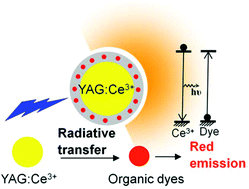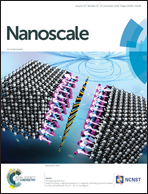Dye-embedded YAG:Ce3+@SiO2 composite phosphors toward warm wLEDs through radiative energy transfer: preparation, characterization and luminescence properties†
Abstract
The most common yellow phosphor for wLEDs, Y3Al5O12:Ce3+ (YAG:Ce3+), suffers from a deficiency of red in its spectral content of light. In this paper, a new strategy is provided to tailor the Ce3+ spectral profile through surface-located dye molecules of ATTO-Rho101, which feature intense, broad absorption in the green-yellow spectral region of Ce3+ emission as well as bright red emission. Sphere-shaped and highly dispersed micrometer and nanometer-sized YAG:Ce3+ (micro/nano-YAG:Ce3+) was synthesized through a modified solvothermal method. Surface SiO2 coating and simultaneous dye embedding were performed on the solvothermally derived YAG:Ce3+, heat-treated micro-YAG:Ce3+ and commercial phosphors. Efficient radiative transfer/reabsorption from Ce3+ in the inner core of YAG to the dye molecules in the SiO2 outer shell, irrespective of the size of the phosphors, was demonstrated in the accumulated YAG:Ce3+@SiO2 + dye powder upon blue light excitation; this enhanced its red emission. Fluorescence microscopy was demonstrated to be a powerful tool to identify the reabsorption phenomenon of the powdered materials. Packaging the heat-treated micro-YAG:Ce3+@SiO2 + dye phosphors on blue LED chips yielded a warm wLED (Ra ∼ 93), but an Ra of only ∼79 was obtained for the wLED with commercial YAG:Ce3+@(SiO2 + dye)5 due to the low concentration of phosphors dispersed in the epoxy resin and the resulting decreased reabsorption by dye molecules. Surface-protonated amine species were found to induce Ce3+ → Ce4+ oxidation upon activation by heating or photoirradiation and then quench the photoluminescence (PL) of micro-YAG:Ce3+ even after surface modification by SiO2, YAG or being embedded in an epoxy resin matrix. High calcination temperatures greatly improved the PL stability of micro-YAG:Ce3+ through the removal of surface-capped species. The dye in the silica matrix showed high stability against heating and irradiation due to the so-called “caging effects”; however, decreased photo-stability was found in commercial YAG:Ce3+@(SiO2 + dye)5 due to the incomplete and/or loose SiO2 layer grown during multiple surface modifications.



 Please wait while we load your content...
Please wait while we load your content...